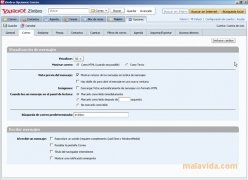

- ZIMBRA DESKTOP APPLICATION INSTALL
- ZIMBRA DESKTOP APPLICATION SOFTWARE
- ZIMBRA DESKTOP APPLICATION CODE
ZIMBRA DESKTOP APPLICATION CODE
The Zimbra Open Source Edition Web Client Code is released under the Common Public Attribution License, version 1.0 (CPAL v.1). With the release of Zimbra Collaboration 8.5, Zimbra officially moved to Open Source Initiative-approved licenses.
ZIMBRA DESKTOP APPLICATION SOFTWARE
We will mark the option to display messages that we like the most.Special Note: Zimbra made key changes to its open source software licensing to build an even stronger foundation for community-powered innovation. In it we will look in the upper right part for a View drop-down. Finally we will leave the Preferences tab, saving the new changes, going to the Mail tab. Even so, we can configure it according to our needs.Ĥ. In it we recommend marking the first four options as in the image. Once the signatures are configured, we will go to the Address Book. Next in Using Signatures we will configure the signatures of New Messages and of Replies & Forwards according to our preferences.ģ. NOTE: We will change the format of the signature to Format As HTML. Here we will create the signature that we want in New Signature, attributing a name and the content of it. We will continue advancing through the menu to Signatures. Here we can configure to our liking different options in Receiving Messages, and classify accounts in Spam Mail Options.Ģ. We will go to the section of Mail, within the account that we are interested in managing. Now we will proceed to configure the accounts individually. The previous configuration, will be useful for all the accounts that we have introduced in Zimbra Desktop. SPECIFIC CONFIGURATION FOR THE DIFFERENT ZIMBRA ACCOUNTSġ. Finally in Retention: we recommend entering 5. In the case of the Location: we will configure it to our liking, depending on where we want to save the copy. In Schedule: we recommend putting Every day, so that the program makes a backup during that period.

In Accounts: we will see all those accounts that we have entered in our Zimbra Desktop let’s point them all out. To finish, we will proceed to configure the Backups of our mail. Finally, in Work week and hours, we can enter our working day so that it appears marked on the agenda.Ħ. In Show reminders we can set up the Zimbra notice form when we have an appointment. Here we can change the Default view according to our preferences and then we will change in Start the week on: (the day we want). We will continue to the Calendar section. In the Preferences in Composing menu we will mark the option Compose: As HTML, choosing the Font, the Size and the Color that we like the most.ĥ. Also at the bottom in Receiving messages, we can configure to our liking notices for new mail.Ĥ. Here we will activate Display mail: As HTML (when possible). We will continue advancing through the Preferences in Mail menu. This will help our operating system recognize Zimbra Desktop as the main mail manager.ģ. After changing the language, in the same tab, located in the Other section, we will mark the option Use Zimbra Desktop as default mail application.
ZIMBRA DESKTOP APPLICATION INSTALL
If we want to introduce a language that is not predefined, we must install it separately.Ģ. First, we will go to the Preferences tab, where we will change the language, if it is not already in English. After installing Zimbra Desktop we will perform a series of steps to perform a basic configuration.


 0 kommentar(er)
0 kommentar(er)
